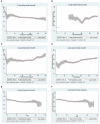COVID-19 self-protective practices and associated factors among secondary school students in Jimma town, Jimma, Oromia, Southwest Ethiopia
- PMID: 36620275
- PMCID: PMC9816375
- DOI: 10.3389/fpubh.2022.1082563
COVID-19 self-protective practices and associated factors among secondary school students in Jimma town, Jimma, Oromia, Southwest Ethiopia
Abstract
Background: Since there is limited evidence regarding COVID-19 self-protective practices among school students, this study assessed COVID-19 self-protective practices and associated factors among secondary school students.
Methods: A school-based cross-sectional study was conducted in Jimma town, Oromia regional state, Southwest Ethiopia from 25 May 2021 to 10 June 2021. The total sample size was 634, and students were randomly selected from public and private secondary schools. A self-administered questionnaire was used for data collection. The data were entered into Epidata 3.1 and analyzed using SPSS 21.0 software. Descriptive statistics, such as proportion and mean, were computed to describe the findings. The composite index was computed for each dimension. A linear regression analysis was used to identify the predictors of self-protective practice. A local polynomial smoothing graph was done using Stata 12 software to visualize the relationship between a significant variable and an outcome variable.
Results: A total of 576 respondents participated in this study, which made a response rate of 90.85%. The mean score for overall knowledge was 31.40 (SD ±8.65). Knowledge about COVID-19 symptoms and preventive practices had a mean score of 23.93 and 45.96, respectively. The mean scores for perceived vulnerability, severity, benefits, barriers, self-efficacy, and school support were 26.37, 33.21, 43.13, 16.15, 33.38, and 25.45, respectively. The mean score for self-protective practice was 28.38 (SD ±11.04). As perceived benefit (AOR = 0.199, p = 0.000, 95% CI: 0.094-0.304), perceived school support (AOR = 0.125, p = 0.009, 95% CI: 0.032-0.218), and self-efficacy (AOR = 0.186, p = 0.000, 95% CI: 0.102-0.270) increased, COVID-19 self-protective practices also increased and vice versa. However, age (AOR = -0.873, p = 0.006, 95% CI = -1.495, -0.251), perceived vulnerability (AOR = -0.107, p = 0.021; 95% CI = -0.199, -0.016), and maternal educational status (no formal education) (AOR = -5.395, p = 0.000, 95% CI = -7.712 to 3.077) had negatively associated with self-protective practices.
Conclusion: COVID-19 self-protective practice is unsatisfactory. Perceived benefit, perceived school support, and self-efficacy are positively associated with it. However, students' age, perceived vulnerability, and maternal educational status (no formal education) were negatively associated with COVID-19 self-protective measures among secondary school students. The findings underscore that there is a need to conduct risk communications among students. Similarly, awareness creation intervention should target mothers with no formal education.
Keywords: COVID-19; Ethiopia; Jimma; secondary school students; self-protection practices.
Copyright © 2022 Birhanu, Tesfaye and Tareke.
Conflict of interest statement
The authors declare that the research was conducted in the absence of any commercial or financial relationships that could be construed as a potential conflict of interest.
Figures



Similar articles
-
Development and validation of Health Belief Model based instrument to assess secondary school student's adherence to COVID-19 self-protective practices in Jimma, Oromia, Ethiopia.PLoS One. 2022 Dec 21;17(12):e0279440. doi: 10.1371/journal.pone.0279440. eCollection 2022. PLoS One. 2022. PMID: 36542638 Free PMC article.
-
Adherence to Covid-19 preventive measures among high school students in Jimma town, South-West Ethiopia: Institutional-based cross-sectional study.PLoS One. 2022 Dec 30;17(12):e0279081. doi: 10.1371/journal.pone.0279081. eCollection 2022. PLoS One. 2022. PMID: 36584185 Free PMC article.
-
Level of health literacy and associated factors among Jimma town public high school adolescent students: A cross-sectional study.PLoS One. 2024 Dec 16;19(12):e0315365. doi: 10.1371/journal.pone.0315365. eCollection 2024. PLoS One. 2024. PMID: 39680532 Free PMC article.
-
Assessment of COVID-19 prevention practice and associated factors in Jimma town, Ethiopia: A mixed study.Front Public Health. 2022 Sep 26;10:950202. doi: 10.3389/fpubh.2022.950202. eCollection 2022. Front Public Health. 2022. PMID: 36225789 Free PMC article.
-
Examining students' level of understanding toward COVID-19 and its associated factors in Ethiopia: a systematic review and meta-analysis.Front Public Health. 2024 Apr 24;12:1369738. doi: 10.3389/fpubh.2024.1369738. eCollection 2024. Front Public Health. 2024. PMID: 38721537 Free PMC article.
References
-
- World Health Organization . Coronavirus Disease (COVID-19) Outbreak: Rights, Roles and Responsibilities of Health Workers, Including Key Considerations for Occupational Safety and Health (2020).
-
- O'Hara LM, Schrank GM, Frisch M, Hogan R, Deal KE, Harris AD, et al. . Coronavirus disease 2019 (COVID-19) symptoms, patient contacts, polymerase chain reaction (PCR) positivity and seropositivity among healthcare personnel in a Maryland healthcare system. Infect Control Hosp Epidemiol. (2021) 2021:1–3. 10.1017/ice.2021.373 - DOI - PMC - PubMed
MeSH terms
LinkOut - more resources
Full Text Sources
Medical
Research Materials

